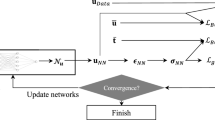Abstract
This article presents a comparative study of the classification of Elliott waves in data. Regarding the methods of classification, the paper deals with three approaches. The first one is a multilayer artificial neural network (ANN) with sigmoid activation function and backpropagation and Levenberg–Marquardt training algorithm. Second approach uses training algorithms of ANN but forms of activation functions of hidden nodes and nodes in output layers have been proposed by analytical programming with the differential evolution. The last approach offers results performed by synthesized pseudo neural networks where the symbolic regression is used for synthesis of a whole structure of the classifier, i.e., the relation between inputs and output(s) similar to ANN. In this case, meta-evolution version of analytic programming with differential evolution is used. In conclusion, all results of this experimental study were evaluated and compared mutually.











Similar content being viewed by others
References
Back T, Fogel DB, Michalewicz Z (1997) Handbook of evolutionary algorithms. Oxford University Press, Oxford, ISBN 0750303921
Bishop CM (1995) Neural networks for pattern recognition. Oxford university press, Oxford, ISBN 978-1-19-853864-6
Elliott RN (1938) The wave principle, reprinted. In: Prechter RR Jr (ed) 1994. R. N, Elliott’s Masterworks
Fausett LV (1993) Fundamentals of neural networks: architectures, algorithms and applications. Prentice Hall, USA, ISBN 9780133341867
Fekiac J, Zelinka I, Burguillo JC (2011) A review of methods for encoding neural network topologies in evolutionary computation. The European Conference on Simulation and Modelling, Krakow, Poland, ISBN 978-0-9564944-3-6
Gurney K (1997) An introduction to neural networks. CRC Press, USA, ISBN 1857285034
Hebb D (1949) The organization of behavior. Wiley, New York
Hertz J, Kogh A, Palmer RG (1991) Introduction to the theory of neural computation. Addison–Wesley, USA
Komínková Oplatková Z, Senkerik R (2013a) Evolutionary synthesis of complex structures—pseudo neural networks for the task of iris dataset classification. In: Nostradamus 2013: prediction, modeling and analysis of complex systems. Springer-Verlag, Heidelberg, pp 211–220, ISBN 978-3-319-00541-6
Kominkova Oplatkova Z, Senkerik R (2013c) Iris data classification by means of pseudo neural networks based on evolutionary symbolic regression. In: 27th European conference on modelling and simulation. ECMS, Alesund, pp 355–360, ISBN 978-0-9564944-6-7
Kominkova Oplatkova Z, Senkerik R, Jasek R (2013b) Comparison between artificial neural net and pseudo neural net classification in Iris dataset case. In: MENDEL 2013 19th international conference on soft computing. Technical University in Brno, Brno, pp 239–244, ISBN 978-80-214-4755-4
Kominkova Oplatkova Z, Senkerik R (2015) Elliott waves classification by means of neural and pseudo neural networks—supplementary material. Avaiable at: http://nod32.fai.utb.cz/promotion/SOCO_Jour_pseudo_NN_output.pdf.Accessed 10 Jan 2015
Koza JR (1998) Genetic programming. MIT Press, USA, ISBN 0-262-11189-6
Miller WT, Werbos PJ, Sutton RS (1995). Neural networks for control. MIT press, USA
O’Neill M, Ryan C (2003) Grammatical evolution: evolutionary automatic programming in an arbitrary language. Kluwer Academic Publishers, New York, ISBN 1402074441
Oplatkova Z (2009) Metaevolution: synthesis of optimization algorithms by means of symbolic regression and evolutionary algorithms. Lambert Academic Publishing, Saarbrücken
Poggio T, Girosi F (1990) Networks for approximation and learning. Proc IEEE 78(9):1481–1497
Price K (1999) An introduction to differential evolution. In: Corne D, Dorigo M, Glover F (eds) New ideas in optimization. McGraw-Hill, London, pp 79–108
Volna E, Kotyrba M, Kominkova Oplatkova Z (2013) Elliott waves classification via softcomputing. In: Proceedings of the 19th international conference on soft computing, Mendel, Czech Republic, Brno, pp 69–74
Volna E, Kotyrba M, Jarusek R (2013) Multiclassifier based on Elliott wave’s recognition. Comput Math Appl 66(2):213–225. https://doi.org/10.1016/j.camwa.2013.01.012
Widrow B, Winter R (1988) Neural nets for adaptive filtering and adaptive pattern recognition. Computer 21(1):25–39
Yao J, Tan CL, Poh HL (1999) Neural networks for technical analysis: a study on KLCI. Int J Theor Appl Financ 2(02):221–241
Zelinka I et al (2011) Analytical programming—a novel approach for evolutionary synthesis of symbolic structures. In: Kita E (ed) Evolutionary algorithms, InTech, ISBN 978-953-307-171-8
Zelinka I, Varacha P, Oplatkova Z (2006) Evolutionary synthesis of neural network. In: Proceedings of 12th international conference on softcomputing—Mendel 2006, no. 12 in MENDEL, Brno University of Technology, VUT Press, Czech Republic, pp 25–31, ISBN 80-214-3195-4
Acknowledgements
The research described here has been financially supported by University of Ostrava grant SGS17/PřF/2015, it was also supported by Grant Agency of the Czech Republic—GACR P103/15/06700S, further by financial support of research project NPU I No. MSMT-7778/2014 by the Ministry of Education of the Czech Republic and also by the European Regional Development Fund under the Project CEBIA-Tech No. CZ.1.05/2.1.00/03.0089. Any opinions, findings and conclusions or recommendations expressed in this material are those of the authors and do not necessarily reflect the views of the sponsors.
Author information
Authors and Affiliations
Corresponding author
Ethics declarations
Conflict of interest
The authors declare that they have no conflict of interest.
Additional information
Communicated by V. Loia.
Rights and permissions
About this article
Cite this article
Volná, E., Kotyrba, M., Oplatková, Z.K. et al. Elliott waves classification by means of neural and pseudo neural networks. Soft Comput 22, 1803–1813 (2018). https://doi.org/10.1007/s00500-016-2097-y
Published:
Issue Date:
DOI: https://doi.org/10.1007/s00500-016-2097-y




